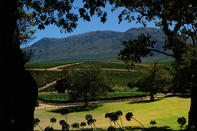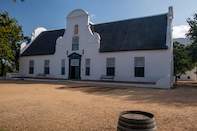First Mountain Road
Back in the day, the loggers responsible for keeping Cape Town stocked with wood were faced with an inevitable problem. As demand for timber grew, supplies started running low on the accessible slopes around the Castle.

Additional trees had to be found. These were discovered growing in great abundance on the Western side of the mountain in a valley called, with customary imagination, Hout Bay (Wood Bay).
But there was a problem. If they wanted to get trees out of Hout Bay, they would have to get wagons in, and this meant building a road from one side of the peaks to the other. In 1666, Commander Wagenaer (Van Riebeeck’s successor) gave the order, and a bunch of soldiers went out with ‘some crowbars, picks and shovels in order to make a road’.
This rough dirt track grew into the lovely road that runs from Groot Constantia Wine Estate, over Constantia Nek, and down into Hout Bay. Originally called Cloof Pass, this was the first mountain road constructed in South Africa.
Oldest Wine Estates in The Cape

The huge farm that Simon van der Stel chose as his reward for services to the Dutch East India Company was named Constantia, apparently in honour of a young woman named Constance who had helped convince the thrifty Company to give away such a prime piece of real estate. By 1685, Van der Stel had built a grand homestead on his new farm, and was busily planting 70 000 grape vines, like Muscadel and Steen. Unfortunately, Van Der Stel died before his efforts bore fruit and, with no descendants living in South Africa, his picture-perfect farm was spilt up and sold off.
Years later, in 1778, Hendrik Cloete bought the piece of land that had become known as Groot Constantia. The property was run down and the vines were mostly dead but, together with his neighbour and relative Johannes Colyn, Cloete restored Van Der Stel’s old manor house and went on to re-plant thousands of grape vines. The estate went on to produce two of the greatest wines in the history of viticulture: the white and red Constantia wines. This nectar was so renowned that kings, generals and duke’s kept it in their cellars for special occasions. Writers like Dickens, Jane Austen and Alexander Dumas all mentioned Constantia wines in their books, and Napoleon drank a bottle every day while he was exiled on St. Helena.
Sadly, the recipe for the original Constantia wines has been lost, and the few remaining bottles aren’t giving away any secrets. Nevertheless, the Constantia Valley still produces a number of fine wines from the few vineyards that haven’t been taken over by suburban housing, and the Constantia wine route is bound to please those who like a spot of plonk.
Klein Constantia
When Simon van der Stel, creator of Groot Constantia, died in 1712, the farm was split into three. The central part was obtained by Hendrick Cloete in 1778, and on his death it was split again - his son Jacob Pieter got the 'groot' part and the younger Johan Gerhard got the 'klein' - it became the farm Klein Constantia.
The Jooste family acquired it in 1980 and gave priority to recreating the unfortified sweet wine that had made Constantia famous in its early years. They discovered rootstock from the original Muscat de Frontignan clone planted at Constantia. Today the Vin de Constance is again winning worldwide acclaim.
Did You Know? The kramat of Sheikh Abdurahman Matebe Shah, who brought Islam to South Africa in the mid-17th century, is located next to the Klein Constantia estate gate.
 Constantia is both an idyllic suburb of modern Cape Town and home to some of the oldest wine estates in the Cape. The sprawling Constantia V...
Constantia is both an idyllic suburb of modern Cape Town and home to some of the oldest wine estates in the Cape. The sprawling Constantia V... The winelands of Constantia and Durbanville share more than just their conveniently close proximity to Cape Town. Their elegant, fruit-rich ...
The winelands of Constantia and Durbanville share more than just their conveniently close proximity to Cape Town. Their elegant, fruit-rich ...